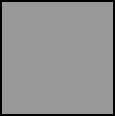
|
Tonal variations in printing are obtained by halftone dots. A matrix of rows and columns of equal spacing can contain larger or smaller dots to visually "mix" with the paper or other colors to fool the eye into seeing tones. Halftone dots are interpreted in terms of percentages. In actuality, a dot of any given percentage is what percent of area that dot covers, but it also means the visual density of the shade it creates. For example, a 20% dot covers 20% of the area of the sheet and appears to be one-fifth as dark as the solid color.
|